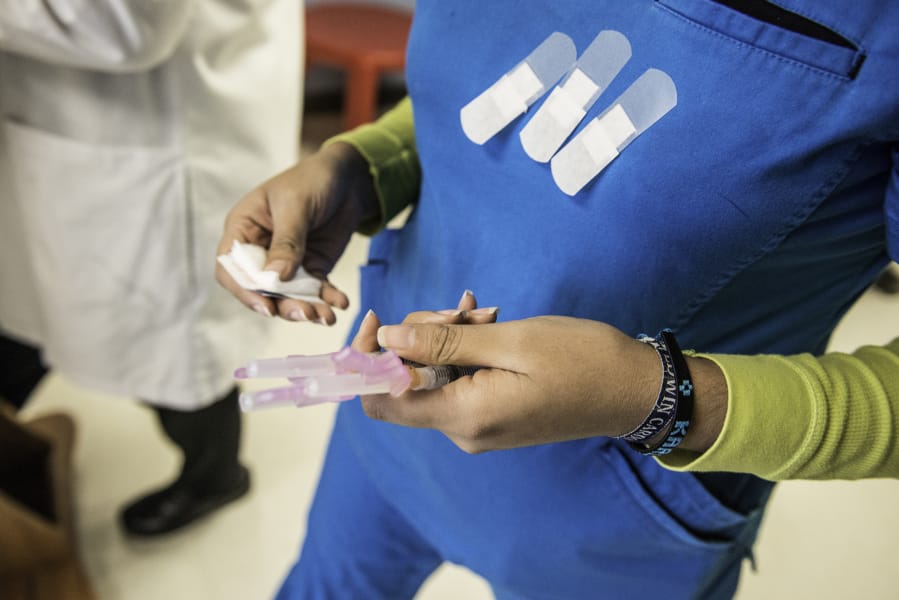A federal public health advisory panel said Wednesday that people through age 45 could benefit from getting an HPV vaccine and should discuss the possibility with their doctors.
The recommendation, which came during a two-day meeting of the Centers for Disease Control and Prevention’s Advisory Committee on Immunization Practices, could expand the pool of people who may have the HPV vaccine covered by their insurance providers.
The vaccine was developed to prevent cancer caused by the human papillomavirus, which is typically transmitted through oral, anal or vaginal sex. The vaccine is currently recommended for preteen girls and boys, to protect them before exposure to the virus, with catchup vaccinations through age 26. In a 10-4 vote, the committee agreed to recommend HPV vaccination for women and men ages 27 to 45 who are not fully vaccinated, through “shared clinical decision-making.”
According to the CDC, most sexually active people will contract HPV at some point. Some people may never know they have it and the active infection may be short-lived because, in most cases, the body’s immune system suppresses the virus. Still, the virus can lead to many types of cancer, including cervical, anal, vaginal, penile and throat cancers.
Each year in the United States, about 17,500 women and 9,300 men get HPV-related cancer — many of which, according to the CDC, are preventable with vaccination.
Broad benefits
A commonly used vaccine, Gardasil 9, is designed to protect against nine HPV strains, seven of which are responsible for 90 percent of HPV-related cancers. Since FDA approval in 2006, studies show that the vaccine has been effective in reducing the number of HPV infections that can lead to cancer, not only by protecting the immunized individuals from disease, but also protecting those with whom they have sexual contact.
Last year, the U.S. Food and Drug Administration expanded its approval for the vaccine to include people in the 27-45 age group.
Public health experts agree that for adults up to age 45, the decision to get the vaccine should be based on each person’s sexual experiences and expectations, and should be discussed with his or her doctor. For example, a middle-aged person re-entering the dating scene who had few previous sexual partners could become exposed to the virus for the first time, and might benefit from the vaccine.
Christopher Zahn, vice president of practice activities at the American College of Obstetricians and Gynecologists, said the vaccine is considered a safe and effective way to reduce the risk of HPV, and though it may not be as practical for older adults, that does not mean there is no benefit for them.
That said, the vaccine may not be right for every adult it is approved for, he said, as it is primarily intended to inoculate children before they are exposed to the virus.
The CDC recommends children receive the first dose of the HPV vaccine between 11 and 12 years of age, then the second dose six months to a year later. However, the vaccine series can be started as young as 9 or after the target age, but those who receive it after age 15 may require three doses instead of two, according to the agency.
Kathleen Schmeler, a gynecological oncologist at MD Anderson Cancer Center, noted that the vaccine may protect older adults from HPV strains they have not yet been exposed to, but it will not protect them from previously acquired infections.
Focus on children
Schmeler said one concern she has is that “if everyone thinks, ‘Oh, well, people can get it up to age 45 so we don’t need to give it to our kids now,’ ” she said. “I just think it’s really important to educate the public that it’s most effective [for children] both because of the kids’ immune response but also because they haven’t been exposed yet.”
Schmeler said there are also cost and global vaccine shortage considerations.
The World Health Organization issued a call to action last year to try to eradicate cervical cancer, one of the most common cancers among women around the world.
Researchers say Australia, Rwanda and some European countries have been leading the charge with national vaccination programs that provide the shots to schoolchildren at no cost and, in fact, these countries may become the first in the world to eliminate HPV and, thus, HPV-related cancers.
Since 2007, when Australia implemented its National HPV Vaccination Program, more than 9 million vaccinations have been given to girls and young women, and there has been a 77 percent reduction in HPV strains that cause most cervical cancer, according to Cancer Council Australia. In 2013, the program was expanded to include boys.
In the United States, HPV vaccination rates have been rising, too, but at a much slower pace — and not fast enough to curb the rising rates of HPV-related cancers.
Public health experts blame access, education and health-care providers who have shown reluctance in recommending the vaccine as strongly as required vaccinations.
Deanna Kepka, an assistant professor in the college of nursing at the University of Utah and an investigator at Huntsman Cancer Institute, said the issue is the way the vaccine was introduced — as a vaccine to protect girls from sexually transmitted disease, rather than one to protect everyone from cancer. She noted oropharyngeal cancers, some of which can be caused by HPV, affect more men each year in the United States than cervical cancer affects women.
Schmeler, the gynecological oncologist, encourage parents to have their children vaccinated, adding, “I spend my days taking care of women with cancer, many of whom die of the disease.”




